
Two opposing teams are competing to be the first to identify all of their team's Disney Treasure Cards from among 16 cards displayed in a 4 x 4 grid.
Each team has a Cluemaster (who knows the location of each one of the
Treasure Cards their team is trying to find) to give clues in the form of code words telling their teammates where to find the cards. Be careful! Decipher a code incorrectly and you might help the other team! It's a race to identify all your team's cards first!
Components
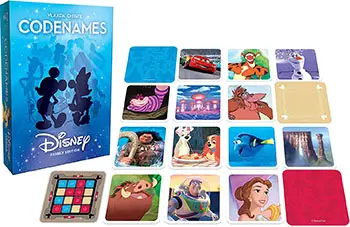
- 200 Treasure Cards
- 60 Key Cards
- 1 Custom Stand
- 8 Blue Cover Cards
- 8 Red Cover Cards
- 7 Neutral Cover Cards
- 1 Extra Cover Cards
- 1 Game-Over Cover Cards
- Instructions
Setup
Players split up into two teams of similar size. At least four players (making two teams of two) are recommended.
Each team chooses one player to be their Cluemaster. Cluemasters sit on the same side of the table while the teammates (guessers) sit across on the opposite side.
Randomly choose 16 Treasure Cards and place them on the table in a 4x4 grid. The grid corresponds to the Easy Key Card that identifies to the Cluemasters which cards are assigned to their team (see page 4). It is recommended to use only all pictures or all words.
Pictures should be oriented so that the images face the guessers, and the word side should have the large words facing the guessers
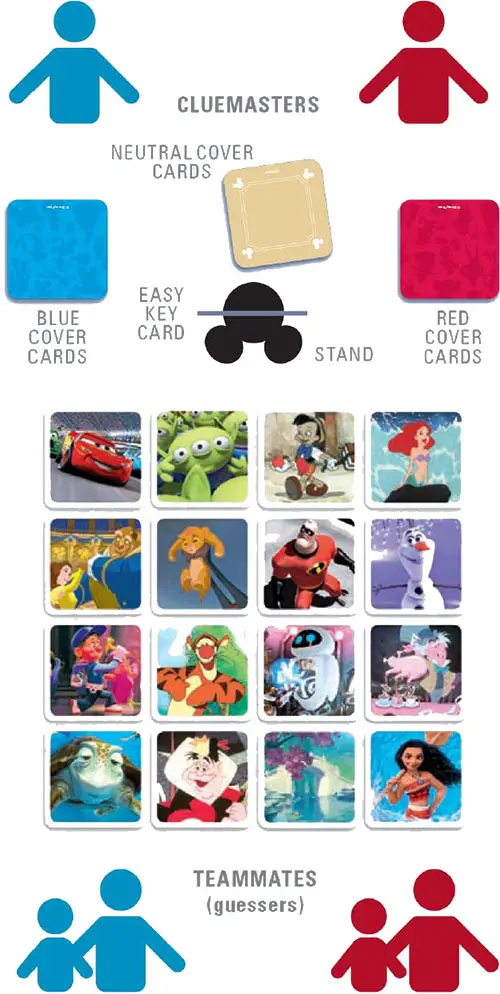
Key Card
Each game will use one Key Card that shows the location of the Treasure Cards for each team. The Cluemasters choose a Key Card randomly and place it (any side up) on the stand between them. DO NOT let teammates see the Key Card.
The Key corresponds to the grid on the table. Red squares indicate cards that the Red Team will try to identify, and blue squares indicate the ones for the Blue Team.
The beige squares indicate neutral cards that do not belong to either team.
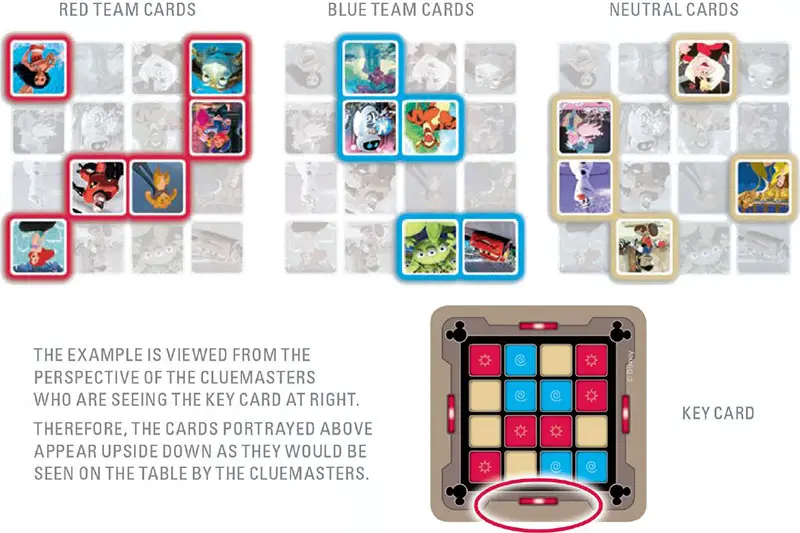
Starting Team
The color bars outside of the grid on any Key Card indicate which team starts (example circled above). The team that starts has 6 Treasure Cards to identify, and the rival team has 5 Treasure Cards to identify.
The starting team also gives the first clue. (Giving clues is explained later).
Each Cluemaster will have 5 of their own Team Cover Cards in front of them, and the starting team will also use the Extra Cover Card as the 6th Cover Card with their color face-up.
Cover Cards
The Blue Team Cover Cards are placed in front of the Blue Team Cluemaster and the Red Team Cover Cards are placed in front of the Red Team Cluemaster.
The Neutral Cover Cards are placed in the center near the Key Card on the Stand.
Note: The Easy Game uses 5 Blue Team Cover Cards and 5 Red Team Cover Cards. Leave the rest in the box.
The Extra Cover Card is added to the starting team's Cover Cards.
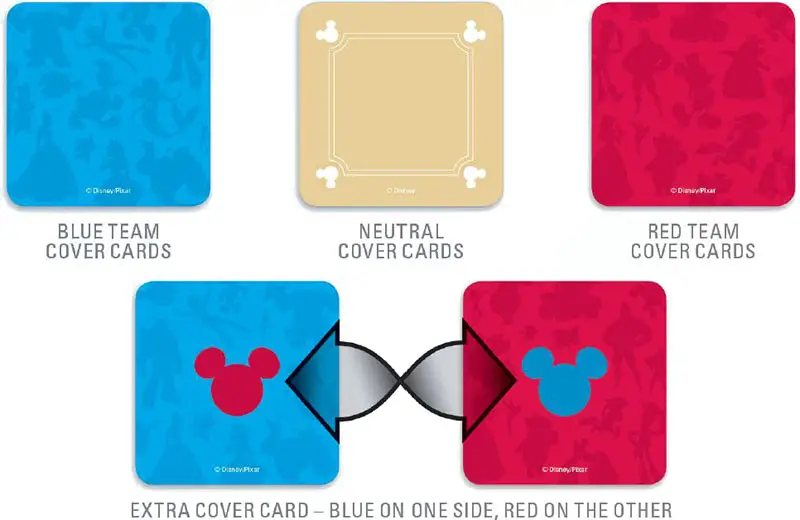
Game Play
Teams take turns, beginning with the starting team. On your team's turn, your Cluemaster gives a one-word clue and the teammates may make one or more guesses. The clue the Cluemaster gives relates to one or more of the Treasure Cards on the table.
After a Cluemaster gives a clue, teammates try to guess which card or cards their Cluemaster alluded to with the clue.
When a teammate touches a Treasure Card, the Cluemaster identifies if that card is one of their team's, one of the rival team's, or one that is neutral, and covers it with the appropriate Cover Card.
Their turn ends when they guess wrong, decide to stop (after at least one guess) or when they have made the maximum number of guesses according to game play, which is the number given by the Cluemaster plus one.
Giving a Clue
If you are the Cluemaster, your job is to think up a clue that relates to one, or better yet, some of the cards your team is trying to guess. Your clue consists of one word that relates to those cards and one number that tells how many of your cards are related to that clue.
Example: A good clue for the two cards below might be SNOW: 2.
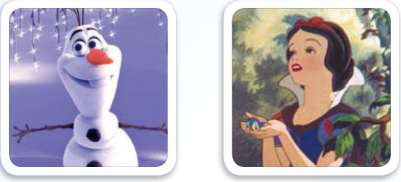
Although your clue must have only one word and one number, the number part of the clue may be 1 or more. It is really fun and beneficial toward winning when your team has the opportunity to guess more than one Treasure Card.
Getting multiple cards with one clue is a big accomplishment!
Keep a Straight Face
Cluemasters are expected to give only one word and one number. Do not preface with additional comments! For instance, "I don't know if you'll get this unless you've seen the classic films" reveals way too much information.
Cluemasters should not appear to be staring at one part of the table, and they must never touch or point toward the cards on the table after they have seen the Key Card.
Cluemasters are also expected to keep a straight face when teammates are guessing. Do not reach for a Cover Card when your teammates begin discussing a card. Wait until they actually touch it. When a teammate chooses a card of the correct color, you must act as though that was the card you meant even if it was not.
If you are a teammate, you should focus on the table when you are making your guesses. To avoid non- verbal clues, avoid making eye contact with the Cluemaster.
When the information is strictly limited to one word and one number, then you are playing fair.
Identifying
After a Cluemaster gives a clue, their teammates try to figure out what it means. They can debate it among themselves, but the Cluemaster must keep a straight face.
Teammates indicate their official guess when one of them touches a card on the table. The Cluemaster identifies if that card is their own team's, the rival team's, or a neutral card.
-
If a player touches a card belonging to their team, the Cluemaster covers it with one of their team's Cover Cards.
Teammates may continue making guesses, but they do not get another clue. (See NUMBER OF GUESSES on the next page).
-
If a player touches a card that belongs to the other team, the card is covered by the rival team's Cover Card. This ends the turn.
(AND helps the other team!)
-
If a player touches a card that is neutral, the Cluemaster covers it with a Neutral Cover Card.
This ends the turn.
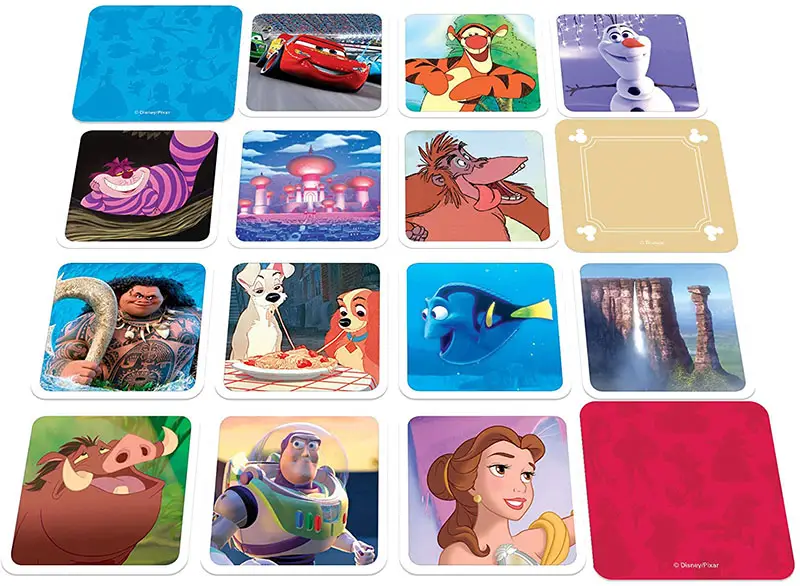
Number of Guesses
Each team's turn always consists of the Cluemaster giving exactly one clue.
A clue consists of one word and one number. The number is determined by the Cluemaster based on how many of their own cards are related to that clue. The guessers on the team always make at least one guess.
Teams can stop guessing at any time, but usually you want to make as many guesses as the number the Cluemaster indicated. Sometimes you might even want to guess one more. The maximum number of guesses a team may make is always one more than the number indicated by the clue.
For example, if your Cluemaster says WATER: 2, you can make as many as three guesses, provided you get the first two guesses correct. This does not make much sense on your first turn, but later in the game it could be very useful.
For instance, you might have been given some clues for which you did not find all the Treasure Cards. You may guess cards for these earlier clues instead of OR in addition to Treasure Cards related to the current clue.
Valid Clues
Remember, your clue needs to be one word, no hyphens or spaces.
If you're not sure your clue is one word or not, ask the rival Cluemaster secretly. If the rival Cluemaster will allow it, the clue is valid.
All word play is allowed. For instance, you can use the word knight to lead teammates to a picture of a sky with moon and stars, OR a picture of a medieval warrior dressed in armor.
If the occasion arises, or the teammates ask, spelling the word out is allowed.
In general, clue giving can be trivially simplistic like identifying an object in the scene. Although a little creativity spices it up for everyone, like saying Quack or Sailor instead of Duck when trying to lead your team to a picture of Donald Duck.*
The clue must be about the card (picture or word), not about the patterns that the cards make on the table, or the letters in certain words. Here are a two examples of what should be considered invalid clues:
 Close : 2 - meaning the two closest cards to the teammates.
Close : 2 - meaning the two closest cards to the teammates. S : 3 - meaning three cards that begin with the letter "S".
S : 3 - meaning three cards that begin with the letter "S".
Titles and names are allowed, as long as they follow the other rules. For instance, "Frozen" works as a clue because it is one word, however "The Little Mermaid" is not allowed.
For the word side, any word (or word with the same root) that is visible on the table is not allowed.
Singing, funny accents and foreign words are generally not allowed, unless your group decides to allow it.
End of the Game
The first team to identify and cover all of their Treasure Cards wins!
It is possible to win on the rival team's turn if they guess your last card.
Advanced Game
Codenames: Disney Family Edition includes an Advanced game play option. The basic game rules are the same, with a few differences. Instead of Easy Key Cards, Advanced Key Cards are used, denoted with Mickey icons on the back side, and feature a 5 x 5 grid instead of the basic 4x4 grid.
Additionally, the grid has one black "Game-Over" square for more challenging game play (details below). Set up the game as usual, except for these modifications:
Draw an Advanced Key Card at random for the Cluemasters (denoted by Mickey icons on the back and 5x5 grid on the front).
Set up a 5 x 5 random Treasure Card grid on the table.
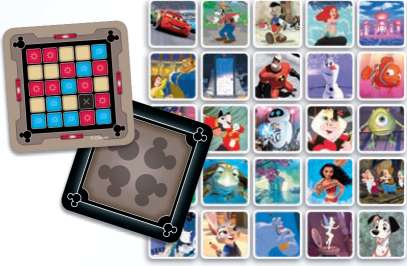
Blue, Red, and Neutral Cover Cards are as usual except you will need more of them. Depending on whether you start, it will now take eight or nine correct guesses to win!
Game play is exactly the same except for the "Game-Over"(black) square. That card should never be guessed by either team. If a team does guess that card it is immediately covered with the Game-Over Cover Card and that team loses the game!
So, more Treasures to be identified, additional challenges, even more fun!
Alternative Game Play
Expert players may want to take advantage of some alternative game play options described below.
Expert Clue: Unlimited
In this variant, as Cluemaster you can allow your teammates to guess as many Treasure Cards as they want by saying unlimited instead of a number. For example, FURRY: UNLIMITED. This is especially helpful if you have given clues for multiple cards that your team has not guessed yet.
The disadvantage is that teammates don't know how many cards relate to the newest clue. The advantage is that they may guess as many cards as they want (with the usual risks).
Expert Clue: Zero
In this variant the Cluemaster is allowed to use zero as the number part of the clue. This would tell your teammates that none of your team's cards relate to that clue. For example, FEATHERS : 0 means "none of our cards relate to feathers".
If the Cluemaster gives "zero" as the number part of the clue, the usual limit on guesses does not apply. Players may guess as many cards as they want (as long as they keep guessing right, of course), however, they still must guess at least one card.
Continue Reading


